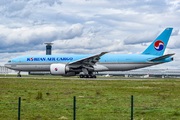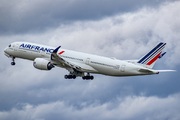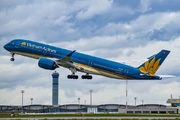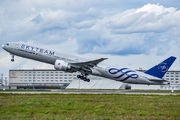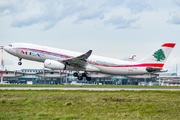Dépêches
Werner Enterprises Reports Improved Fourth Quarter and Annual 2011 Revenues and Earnings
Dépèche transmise le 26 janvier 2012 par Business Wire
OMAHA, Neb.--(BUSINESS WIRE)--Werner Enterprises, Inc. (NASDAQ: WERN), one of the nation’s largest transportation and logistics companies, reported improved revenues and earnings for the fourth quarter and year ended December 31, 2011 compared to the same periods of 2010.
Summarized financial results for fourth quarter and year 2011 compared to fourth quarter and year 2010 are as follows (dollars in thousands, except per share data):
| 4Q11 | 4Q10 | % Change | 2011 | 2010 | % Change | ||||||||||||||
| Total revenues | $507,937 | $463,214 | 10% | $2,002,850 | $1,815,020 | 10% | |||||||||||||
| Trucking revenues, net of fuel | |||||||||||||||||||
| surcharge | $329,110 | $327,682 | 0% | $1,310,612 | $1,287,068 | 2% | |||||||||||||
| Value Added Services (“VAS”) | |||||||||||||||||||
| revenues | $79,674 | $59,834 | 33% | $291,109 | $250,983 | 16% | |||||||||||||
| Operating income | $49,399 | $40,627 | 22% | $173,674 | $134,582 | 29% | |||||||||||||
| Net income | $29,368 | $24,115 | 22% | $102,757 | $80,039 | 28% | |||||||||||||
| Earnings per diluted share | $0.40 | $0.33 | 21% | $1.40 | $1.10 | 28% | |||||||||||||
Werner Enterprises achieved annual earnings in excess of $100 million for the first time in our history. Fourth quarter 2011 was the eighth consecutive quarter in which Werner achieved year-over-year earnings growth in excess of 20%. We are very appreciative of our customers’ support and sincerely thank all of our associates for their dedication, commitment and hard work in passing this mile marker on the road to improving results. With a comprehensive portfolio of superior service offerings, a newer truck fleet, an outstanding team of associates and a strong financial position, we are excited about the prospects for 2012 and beyond.
Fourth quarter 2011 freight demand (as measured by our daily morning ratio of loads to trucks in our one-way truckload network) was better than fourth quarter 2010 and showed more traditional seasonal trends. Our freight demand progressively improved from September to December, before the normal seasonal decline which began during the second week of December. Our morning loads-to-trucks ratio was balanced for fourth quarter 2011 with a seasonal positive strengthening in November and early December. We continue to believe that favorable truckload demand trends are caused to a greater degree by supply side constraints limiting truckload capacity, as compared to growing demand generated by increased economic activity.
Average revenues per total mile, net of fuel surcharge, increased 4.6% in fourth quarter 2011 compared to fourth quarter 2010. Contractual rate increases, an improved freight mix and better surge pricing were the primary reasons for the rate improvement. Several larger sized seasonal projects in fourth quarter 2011 also aided the increase in our revenue per total mile. We continue to be successful in this tightening capacity environment by working jointly with our customers to secure sustainable transportation solutions across all modes.
We remain committed to maintaining our truck count at approximately 7,300 trucks. In the last six months, our truck count has operated slightly below this level due to the increasingly challenging driver market. Our primary objectives continue to be expanding our operating margin percentage and improving our returns on assets, equity and invested capital, while staying true to our broad transportation services portfolio.
Capacity in our industry remains constrained by economic, safety and regulatory factors. From 2007 to 2010, the number of new class 8 trucks built was well below historical replacement levels for our industry. This led to the oldest average industry truck age in 40 years. Carriers were compelled to upgrade their aging truck fleets which led to increased replacement purchases of new and later-model used trucks in 2011. However, we do not believe that industry fleet growth is occurring, as some carriers are already struggling to finance the replacement truck upgrade due to the large pricing gap between the significantly increased costs of EPA-compliant new trucks compared to the lower value of record-old trucks. For example, the average cost of new trucks purchased in 2011 is approximately 30% higher than the average cost of trucks being sold in 2011.
We continue to diversify our business model with the goal of achieving a balanced portfolio of revenues comprised of One-Way Truckload (which includes the Regional, medium-to-long-haul Van and Expedited fleets), Specialized Services and Logistics (VAS). Our Specialized Services unit, primarily Dedicated, ended the quarter with 3,475 trucks (or 48% of our total fleet).
Diesel fuel prices were 63 cents per gallon higher in fourth quarter 2011 than in fourth quarter 2010 and were 2 cents per gallon lower than in third quarter 2011. For the first 26 days of January 2012, the average diesel fuel price per gallon was 41 cents higher than the average diesel fuel price per gallon in the same period of 2011 and 14 cents higher than in first quarter 2011.
The driver recruiting and retention market became more challenging during fourth quarter 2011. Assuming the domestic economy strengthens in 2012, we anticipate the driver market will become even more challenging in 2012. While historically higher national unemployment rates have aided our driver recruiting and retention efforts, we believe that an improved freight market, extended unemployment benefit payment programs, a reduction in available truck driving school graduates and changing industry safety regulations are tightening driver supply. While we are not immune to fluctuations in the driver market, we continue to believe we are in a better position in the current market than many competitors because over 70% of our driving jobs are in more attractive, shorter-haul Regional and Dedicated fleet operations that enable us to return these drivers to their homes on a more frequent and consistent basis.
Gains on sales of assets were $4.8 million in fourth quarter 2011 compared to $2.8 million in fourth quarter 2010 and $6.0 million in third quarter 2011. The market for the sale of used trucks and trailers remains strong. Gains on sales are reflected as a reduction of Other Operating Expenses in our income statement.
We continue to buy new trucks to replace older trucks we sell or trade. We continue to invest in environmentally friendly equipment solutions such as more aerodynamic truck features, idle reduction systems, tire inflation systems and trailer skirts. Over the last three years, Werner Enterprises has reduced its annual carbon footprint by over 140,000 tons. Our net capital expenditures in 2011 were $232.2 million. We expect our net capital expenditures in 2012 to be in a range of $160 million to $210 million. During 2011, we reduced the average age of our company truck fleet from 2.8 years at December 31, 2010 to 2.4 years at December 31, 2011. We expect to further reduce our company truck fleet age to approximately 2.1 years by December 31, 2012. We remain committed to the ongoing investment required to maintain a best-in-class fleet while focusing on the lowest operating cost model for our customers.
To provide shippers with additional sources of managed capacity and network analysis, we continue to develop our non-asset-based VAS segment. VAS includes Brokerage, Freight Management, Intermodal and Werner Global Logistics (International).
| Value Added Services | 4Q11 | 4Q10 | 2011 | 2010 | ||||||||||||||||||||||||
|
(amounts in 000’s) |
$ | % | $ | % | $ | % | $ | % | ||||||||||||||||||||
| Revenues | $ | 79,674 | 100.0 | $ | 59,834 | 100.0 | $ | 291,109 | 100.0 | $ | 250,983 | 100.0 | ||||||||||||||||
| Rent and purchased transportation | ||||||||||||||||||||||||||||
| expense | 65,829 | 82.6 | 50,553 | 84.5 | 244,194 | 83.9 | 213,567 | 85.1 | ||||||||||||||||||||
| Gross margin | 13,845 | 17.4 | 9,281 | 15.5 | 46,915 | 16.1 | 37,416 | 14.9 | ||||||||||||||||||||
| Other operating expenses | 8,012 | 10.1 | 6,519 | 10.9 | 29,879 | 10.2 | 26,411 | 10.5 | ||||||||||||||||||||
| Operating income | $ | 5,833 | 7.3 | $ | 2,762 | 4.6 | $ | 17,036 | 5.9 | $ | 11,005 | 4.4 | ||||||||||||||||
The following table shows the change in shipment volume and average revenue (excluding logistics fee revenue) per shipment for all VAS shipments.
| % | % | |||||||||||||||||||||||||||||||
| 4Q11 | 4Q10 | Difference | Change | 2011 | 2010 | Difference | Change | |||||||||||||||||||||||||
|
Total VAS shipments |
67,666 |
60,884 |
6,782 |
11% |
254,926 |
261,396 |
(6,470 |
) |
(2)% |
|||||||||||||||||||||||
| Less: Non-committed | ||||||||||||||||||||||||||||||||
| shipments to Truckload | ||||||||||||||||||||||||||||||||
| segment | 20,337 | 20,499 | (162 | ) | (1)% | 78,842 | 93,760 | (14,918 | ) | (16)% | ||||||||||||||||||||||
| Net VAS shipments | 47,329 | 40,385 | 6,944 | 17% |
176,084 |
167,636 |
8,448 |
5% |
||||||||||||||||||||||||
| Average revenue per | ||||||||||||||||||||||||||||||||
| shipment | $1,554 | $1,376 | $178 | 13% | $1,536 | $1,346 | $190 | 14% | ||||||||||||||||||||||||
In fourth quarter 2011, VAS revenues increased 33%, gross margin dollars increased 49% and operating income dollars increased 111% compared to fourth quarter 2010.
Brokerage revenues in fourth quarter 2011 increased 19% compared to fourth quarter 2010 due to a 9% increase in shipment volume and a 10% increase in average revenue per shipment. Brokerage gross margin dollars and gross margin percentage increased both year-over-year and sequentially. Intermodal revenues increased 75%, and Intermodal operating income increased by an even higher percentage, comparing fourth quarter 2011 to fourth quarter 2010. Werner Global Logistics revenues increased 52% and operating results improved significantly in fourth quarter 2011 compared to fourth quarter 2010.
Comparisons of the operating ratios (net of fuel surcharge revenues) for the Truckload segment and VAS segment for fourth quarters and full years 2011 and 2010 are shown below.
|
Operating Ratios |
4Q11 | 4Q10 | Difference | 2011 | 2010 | Difference | |||||||||||||||||||||||||
|
Truckload Transportation Services |
87.1 | % | 88.4 | % | (1.3 | )% | 88.1 | % | 90.6 | % | (2.5 | )% | |||||||||||||||||||
| Value Added Services | 92.7 | 95.4 | (2.7 | )% | 94.1 | 95.6 | (1.5 | )% | |||||||||||||||||||||||
Fluctuating fuel prices and fuel surcharge collections impact the total company operating ratio and the Truckload segment’s operating ratio when fuel surcharges are reported on a gross basis as revenues versus netting against fuel expenses. Eliminating fuel surcharge revenues, which are generally a more volatile source of revenue, provides a more consistent basis for comparing the results of operations from period to period. The Truckload segment’s operating ratios for fourth quarter 2011 and fourth quarter 2010 are 89.9% and 90.4%, respectively, and for 2011 and 2010 are 90.7% and 92.1%, respectively, when fuel surcharge revenues are reported as revenues instead of a reduction of operating expenses.
Our financial position remains strong. We ended 2011 with no debt, $12.4 million of cash, and stockholders’ equity of $725.1 million, after paying a $36.4 million special dividend to shareholders in December 2011.
| INCOME STATEMENT DATA | ||||||||||||||||
| (Unaudited) | ||||||||||||||||
| (In thousands, except per share amounts) | ||||||||||||||||
| Quarter | % of | Quarter | % of | |||||||||||||
| Ended | Operating | Ended | Operating | |||||||||||||
| 12/31/11 | Revenues | 12/31/10 | Revenues | |||||||||||||
|
|
||||||||||||||||
| Operating revenues | $507,937 | 100.0 | $463,214 | 100.0 | ||||||||||||
| Operating expenses: | ||||||||||||||||
| Salaries, wages and benefits | 136,253 | 26.8 | 130,684 | 28.2 | ||||||||||||
| Fuel | 100,695 | 19.8 | 85,199 | 18.4 | ||||||||||||
| Supplies and maintenance | 40,778 | 8.0 | 38,525 | 8.3 | ||||||||||||
| Taxes and licenses | 22,545 | 4.5 | 23,804 | 5.1 | ||||||||||||
| Insurance and claims | 17,329 | 3.4 | 18,286 | 4.0 | ||||||||||||
| Depreciation | 39,473 | 7.8 | 39,394 | 8.5 | ||||||||||||
| Rent and purchased transportation | 100,289 | 19.8 | 84,287 | 18.2 | ||||||||||||
| Communications and utilities | 3,569 | 0.7 | 3,867 | 0.8 | ||||||||||||
| Other | (2,393 | ) | (0.5 | ) | (1,459 | ) | (0.3 | ) | ||||||||
| Total operating expenses | 458,538 | 90.3 | 422,587 | 91.2 | ||||||||||||
| Operating income | 49,399 | 9.7 | 40,627 | 8.8 | ||||||||||||
| Other expense (income): | ||||||||||||||||
| Interest expense | 42 | 0.0 | 30 | 0.0 | ||||||||||||
| Interest income | (421 | ) | (0.1 | ) | (412 | ) | (0.1 | ) | ||||||||
| Other | (210 | ) | (0.0 | ) | (38 | ) | (0.0 | ) | ||||||||
| Total other expense (income) | (589 | ) | (0.1 | ) | (420 | ) | (0.1 | ) | ||||||||
| Income before income taxes | 49,988 | 9.8 | 41,047 | 8.9 | ||||||||||||
| Income taxes | 20,620 | 4.0 | 16,932 | 3.7 | ||||||||||||
| Net income | $29,368 | 5.8 | $24,115 | 5.2 | ||||||||||||
| Diluted shares outstanding | 73,289 | 72,989 | ||||||||||||||
| Diluted earnings per share | $0.40 | $0.33 | ||||||||||||||
| OPERATING STATISTICS | ||||||||||||||||
| Quarter Ended | Quarter Ended | |||||||||||||||
| 12/31/11 | % Change | 12/31/10 | ||||||||||||||
| Trucking revenues, net of fuel surcharge (1) | $329,110 | 0.4% | $327,682 | |||||||||||||
| Trucking fuel surcharge revenues (1) | 92,598 | 31.9% | 70,189 | |||||||||||||
| Non-trucking revenues, including VAS (1) | ||||||||||||||||


